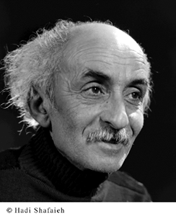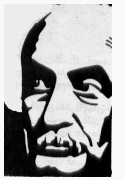
Click on image to see larger version of photo. |
by
copyright, Bashiri 2000 |

Click on image to see larger version of photo. |
by
copyright, Bashiri 2000 |
The impact of western society, especially western democracy and technological innovations, on Iran is visible in the latter's adoption of a constitution, creation of houses of parliament, as well as in the development of a western-style system of education, introduction of printing presses, support for a media, and translation into Persian of the works of noteworthy western authors. Alongside these prominent reforms, there were other albeit less visible changes including a revision of language use, gravitation towards the arts at the expense of the sciences, and an improved military and intelligence services. The changes in literature affected both the prose and poetry genres. The uneven emphasis on literature was quite consistent with the interests of the west which intended to turn countries like Iran into consumer markets for its factories.
Western thought developed gradually in Iranian society. Both the form and the contents of the works of Iraj Mirza, Mirzadeh 'Eshqi, Abul-Qasim Lahuti, and Nima Yushij testify to the ever-growing fascination of the Iranian elites with things western. Indeed, a great deal of effort was expended to westernize Iranian society while retaining the coutriy's Perso-Islamic heritage. Nima Yushij, for instance, who spent the better part of his life learning the ways of the masters, came to the conclusion that not only the content but the form of Persian poetry must be recast.
In the she'r-i now (new poetry) rhythm takes the center stage. The poets of new poetry compose their poetry according to the rhythm of natural speech rather than according to a set of predetermined meters (awzan). Visually, this choice plays havoc with the aesthetics of the poem as the bayts lose their traditional symetric balance; one line may contain a single word while other lines might accommodate a long string of words. Harmony, too, is achieved differently. The monotonous traditional metric-based stanza gives way to a dynamic harmony achieved through a cumulation of the effect of natural speech rhythm on the ear.
Finally, new poetry seeks distance from traditional poetry not only in abandoning the metric system and the rhyme but also in the choice of content. True advocates of new poetry devote the entire content of their poems to descriptions of the trials and tribulations of contemporary society. To them the ID card, the computer chip, the pizza, and the web serve as means in the same way that the rose, the nightingale, the moth, and the candle served their predecessors. They are used to express the joys and suffering of individuals and groups at the threshold of losing their identity.
Nima Yushij (his real name is Ali Esfandiyari), the eldest son of Ebrahim Nuri of Yush (Mazandaran province of Iran), was born in November 1896. He grew up in Yush, mostly helping his father with the farm and taking care of the cattle. As a boy, he visited many local summer and winter camps and mingled with shepherds and itenary workers. Life around the camp fire, especially images emerging from the shepherds' simple and entertaining stories about village and tribal conflicts, impressed him greatly. These images, etched in the young poet's memory waited until his power of diction developed sufficiently to release them.
Nima's early education took place in a maktab. A truant student, the mullah had to seek him out in the streets, drag him to school, and punished him. At the age of twelve, Nima was taken to Tehran and registered at the St. Louis School. The atmosphere at the Roman Catholic school did not change Nima's ways, but the instruction of a thoughtful teacher did. Nizam Vafa, a major poet himself, took the budding poet under his wing and nurtured his poetic talent.
Instruction at the Catholic school was in direct contrast to instruction at the makteb. Similarly, living among the urban people was at variance with life among the tribal and rural peoples of the north. In addition, both these lifestyles differed greatly from the description of the lifestyle about which he read in his books or listened to in class. Although it did not change his attachment to tradition, the difference set fire to young Nima's imagination. In other words, even though Nima continued to write poetry in the tradition of Sa'di and Hafiz for quite some time his expression was being affected gradually and steadily. Until, eventually, a time came when the impact of the new became too overwhelming. It overpowered the tenacity of tradition and led Nima down a new path. Consequently, Nima began to replace the familar devices that he felt were impeding the free flow of ideas with innovative, even though less familiar devices that enhanced a free flow of concepts. "Ay Shab" (O Night) and "Afsaneh" (Myth) belong to this transitional period in the poet's life (1922).
In general, Nima manipulated rhythm and rhyme and allowed the length of the line to be determined by the depth of the thought being expressed rather than by the conventional Arabic meters that had dictated the length of a bayt since the early days of Persian poetry. Furthermore, he emphasized current issues, especially nuances of oppression and suffering, at the expense of the beloved's moon face or the ever-growing conflict between the lover, the beloved, and the rival. In other words, Nima realized that while some readers were enthused by the charms of the lover and the coquettish ways of the beloved, the majority preferred heroes with whom they could identify.
Furthermore, Nima enhanced his images with personifications that were very different from the "frozen" imagery of the moon, the rose garden, and the tavern. His unconventional poetic diction took poetry out of the rituals of the court and placed it squarely among the masses. The natural speech of the masses necessarily added local color and flavor to his compositions. Lastly, and by far Nima's most dramatic element was the application of symbolism. His use of symbols was different from the masters in that he based the structural integrity of his creations on the steady development of the symbols incorporated. In this sense, Nima's poetry could be read as a dialog among two or three symbolic references building up into a cohesive semantic unit. In the past only Hafiz had attempted such creations in his Sufic ghazals. The basic device he employed, however, was thematic, rather than symbolic unity. Symbolism, although the avenue to the resolution of the most enigmatic of his ghazals, plays a secondary role in the structural makeup of the composition.
The venues in which Nima published his works are noteworthy. In the early years when the presses were controlled by the powers that be his poetry, deemed below the established norm, was not allowed publication. For this reason, many of Nima's early poems did not reach the public until the late 1930s. After the fall of Reza Shah, Nima became a member of the editorial board of the "Music" magazine. Working with Sadeq Hedayat, he published many of his poems in that magazine. Only on two occasions he published his works at his own expense: "The Pale Story" and "The Soldier's Family."
The closing of "Music" coincided with the formation of the Tudeh Party and the appearance of a number of leftist publications. Radical in nature, Nima was attracted to the new papers and published many of his ground-breaking compositions in them.
Ahmad Zia Hashtroudy and Abul Ghasem Janati Atayi are among the first scholars to have worked on Nima's life and works. The former included Nima's works in an anthology entitled "Contemporary Writers and Poets" (1923). The selections presented were: "Afsaneh," (Myth) "Ay Shab" (O Night), "Mahbass" (Prison), and four short stories. The latter published a volume dealing with the life and works of the poet (1954).
by
translated by
|
The moon beams
the glowworm glows
sleep is seldom ruined, but
worry over this heedless lot
ruins sleep in my tearful eyes.
Dawn stands worried at my side
morning urges me to announce
its arrival to the lot.
alas! a thorn inside,
stops me in my tracks.
A delicate rose stem
which I planted with my hands
and watered with my life
its thorns break inside me.
I fumble about to open a door
uselessly expecting someone to meet
a jumble of walls and doors
crumbles over my head.
The moon beams
the glowworm glows
blisters marking a distant road
Standing before the village
a single man
knapsack on his back, hand on the knocker, murmurs
"Worry over this lot
ruins sleep in my tearful eyes."
by
|
Above the narrow pass, the shattered and desolate and drunken
wind whirls downward.
The entire world is desolated by it
so are my senses!
Oh, piper who has lost the road entranced by the melody of the flute,
where are you?
My house is cloudy but
the cloud is on the verge of weeping.
In the memory of my bright days that slipped through my fingers,
I cast a look upon my sun on the threshold of the ocean
and the entire world is desolated and shattered by the wind
and on the road, the piper continues to play his flute,
by
|
Along the riverbank wanders the old turtle
the day's a sunny day.
The rice-paddy scene is warm.
The old turtle basks in the warm lap of its sun,
Along the riverbank there's only me
tired from the pain of desire,
awaiting my sun.
But my eyes
cannot see it for an instant.
My sun
has hidden its face from me in the distant waters.
For me everything is clear everywhere
in my standing,
in my hurrying,
only my sun is not clear
along the riverbank.
|
| by
|
Yellow hasn't become red for no reason
the red hasn't cast its color
upon the wall for no reason.
Morning has come from that side of the Azakoo mountains but
Vazna Mountain is not clear.
The power of the dimly-lit snow works all its chaos
on every window-pane it settles.
Vazna is not clear
from this, I have a heavy heart;
the guest-killing guesthouse's day is dark
every soul jumbled together aimlessly:
some sleepy people
some uncouth people
some simple people.

| by
|
Hey, you over there
who are sitting pleasantly on the shore,
bread on your tablecloths, clothes on your bodies,
someone is calling you from the water.
He beats the heavy wave with his tired hand,
his mouth agape, eyes torn wide with terror,
he has seen your shadows from afar,
has swallowed water in the dark blue deep,
each moment his impatience grows.
He raises from these waters
a foot, at times,
at times, his head...
Hey you there,
he still has his eyes on this old world from afar,
he's shouting and hopes for help.
Hey you there
who are calmly watching from the shore,
the wave beats on the silent shore, spreads
like a drunk fallen on his bed unconscious,
recedes with a roar, and this call comes from afar again:
Hey, you over there...
And the sound of the wind
more heart-rending by the moment,
and his voice weaker in the sound of the wind;
from waters near and far
again this call is heard:
Hey, you over there...